The Mongols and
Timurids
The
Mongols appear in history at the end of the twelfth century. In the
opening decades of the thirteenth century, Chinggis (or Genghis) Khan
(1167-1227) unified the Mongol tribes on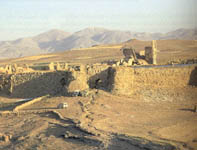 the steppe lands to the north of China and thereafter Mongol armies
invaded China and the Middle East. In 1220 Transoxania was conquered and
in the 1220s roaming Mongol armies spread devastation in the Middle East
as far west as the Caucasus. Mongol occupation of the Middle East to the
south and west of the Oxus began in the 1250s. In 1256 they occupied
northern Iran and in 1258 captured Baghdad and murdered the city's last
Abbasid caliph. In 1260s the Mongols were defeated by a Mamluk army from
Egypt at Ayn
the steppe lands to the north of China and thereafter Mongol armies
invaded China and the Middle East. In 1220 Transoxania was conquered and
in the 1220s roaming Mongol armies spread devastation in the Middle East
as far west as the Caucasus. Mongol occupation of the Middle East to the
south and west of the Oxus began in the 1250s. In 1256 they occupied
northern Iran and in 1258 captured Baghdad and murdered the city's last
Abbasid caliph. In 1260s the Mongols were defeated by a Mamluk army from
Egypt at Ayn 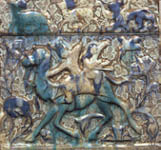 Jalut in
Palestine, which prevented their further spread westwards. They
established an Ilkhanate, a territorial principality that included Iran,
Iraq, and parts of Anatolia and the Caucasus. The Ilkhan Ghazan (Ilkhan
means "subordinate Khan") became a Muslim and from then on
Islam was the official religion of the principality. Jalut in
Palestine, which prevented their further spread westwards. They
established an Ilkhanate, a territorial principality that included Iran,
Iraq, and parts of Anatolia and the Caucasus. The Ilkhan Ghazan (Ilkhan
means "subordinate Khan") became a Muslim and from then on
Islam was the official religion of the principality.
Timur (also known in the West as Tamerlane or Tamburlaine),
who had begun his career as a rustler and brigand in in Transoxania,
made a determined attempt to reconstitute the Mongol world empire (two
of his wives were descended from Chinggis Khan). The empire he
ultimately created consisted essentially of Persia, Iraq, Khurasan, and
Transoxania, but he also campaigned in Syria, Anatolia, the Caucasus , Russia, Afghanistan, and India and, at the time of his death
in 1405, was preparing to invade China.
Caucasus , Russia, Afghanistan, and India and, at the time of his death
in 1405, was preparing to invade China.
As has been said, in the early centuries of Islam there were no royal
workshops as such, and craft workers were hired and brought together for
specific projects. However, libraries seem to have become important
centres for the sponsorship of the arts in 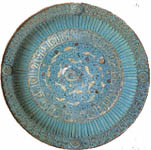 the
period after the Mongol invasion, under the Ilkhans and their successors
in Iran. It is possible that the source of inspiration for this
institutional innovation may have come from the Chinese academies of
history and painting with which the Mongols had become familiar in the
east. One broad consequence of this development is that illustrated
books, and those who worked on books, on their calligraphy, their page
layout, their gilding, and the designs of the leather bindings, became
of central importance for developments in other fields of art and
architecture. Thus under the Timurids designs that were first developed
for books provided templates for work done in the
period after the Mongol invasion, under the Ilkhans and their successors
in Iran. It is possible that the source of inspiration for this
institutional innovation may have come from the Chinese academies of
history and painting with which the Mongols had become familiar in the
east. One broad consequence of this development is that illustrated
books, and those who worked on books, on their calligraphy, their page
layout, their gilding, and the designs of the leather bindings, became
of central importance for developments in other fields of art and
architecture. Thus under the Timurids designs that were first developed
for books provided templates for work done in other media - in stone-cutting, tiles, ceramics, mother-of pearl, saddle work,
and tent-making. Chinese influence may lie behind the restrained and
sombre palette seen not only in the illustrations to books like the
"Demotte" Shahnama, but also in the dark colours
favoured in the Iranian Sultanabad and Lajvardina ceramic wares
produced in this period. The Mongol elite and in particular the Ilkhan
Ghazan took a great interest in the history of their people as well as
of the wider world that they had plans to conquer. this taste, which
resulted in the production of illustrated histories, continued in the
Iranian and Turkish cultural area under the patronage of such dynasties
as the Timurids and the Ottomans.
other media - in stone-cutting, tiles, ceramics, mother-of pearl, saddle work,
and tent-making. Chinese influence may lie behind the restrained and
sombre palette seen not only in the illustrations to books like the
"Demotte" Shahnama, but also in the dark colours
favoured in the Iranian Sultanabad and Lajvardina ceramic wares
produced in this period. The Mongol elite and in particular the Ilkhan
Ghazan took a great interest in the history of their people as well as
of the wider world that they had plans to conquer. this taste, which
resulted in the production of illustrated histories, continued in the
Iranian and Turkish cultural area under the patronage of such dynasties
as the Timurids and the Ottomans.
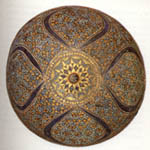 Ghazan
was credited by his vizier, Rashid al-Din, with a range of craft skills:
the Ilkhan was reputed to be expert in woodwork and goldsmithery, he
painted, and painted, and he made saddles, bridles, and spurs. The
notion that a ruler, or indeed any leading member of the military elite,
should possess some artistic or artisanal skill seems to have been widespread
among the Mongols and Turks. Ghazan
was credited by his vizier, Rashid al-Din, with a range of craft skills:
the Ilkhan was reputed to be expert in woodwork and goldsmithery, he
painted, and painted, and he made saddles, bridles, and spurs. The
notion that a ruler, or indeed any leading member of the military elite,
should possess some artistic or artisanal skill seems to have been widespread
among the Mongols and Turks.
Timur's son and successors, Shah Rukh, seems to have
regarded Ghazan as his exemplar. His patronage and that of his wife,
Gawharshad, were conceived of in largely religious terms. Here it is
worth nothing that women played a much more important role both in
politics and in art patronage in the Ilkhanid and Timurid empires than
they had done under earlier Arab and Turkish regimes. Timur's chief
wife, Saray Mulk Khanum, had built a madrasa opposite the Friday
Mosque in Samarqand. Another queen, Tuman-agha, built a Sufi khanqa
(foundation). Gawharshad commissioned a mosque-madrasa complex in
Herat, as well as paying for restoration work or improvements on
existing religious monuments.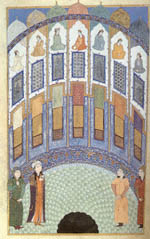
Baysunqur, the son of Shah Rukh, who predeceased his father
in 1434, was an expert calligrapher and bookbinder who also painted and
wrote poetry. However, what makes him particularly interesting to
students of Islamic artistic patronage is his establishment of what was
effectively a design workshop in 1420s. We know an unusual amount about
this workshop because of an arzadasht, or petition document; this
was a sort of progress report by the head of the establishment that was
sent to Baysunqur around 1429. The workshop or kitabkhana
(literally, a store for keeping books, but in practice a library and
workshop for the production of manuscripts and other artefacts) employed
forty calligraphers, plus designers, painters, bookbinders,
stone-cutters, and workers on luxury tents. Some twenty-two projects in hand
were reported on. Thus a great deal of artistic patronage was channelled
through and overseen by a princely "library".
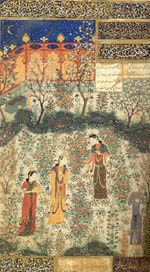 Not all
the great patrons of the Timurid period were of royal blood. Mir Ali
Shir Navai (1441-1501) was the courtier and cup companion of Husayn
Bayqara, the Timurid ruler in Herat from 1470 to 1506. Navai is chiefly
famous today as the greatest poet to write in Chagatay Turkish. He was
also a wealthy man and as such enormously important as a patron of
architecture and art. He spent great sums of money perpetuating his
memory through buildings; according to him: "Whoever builds a
structure that is destined [to remain], when [his] name is inscribed
therein,/For as long as the structure lasts, that name will be on the
lips pf the people." Navai was also a patron of the arts of the
book. Bihzad, who was to become widely recognized as the greatest
miniature-painter of his age, was given a start in his career by being
employed as head of Navai's library. Not all
the great patrons of the Timurid period were of royal blood. Mir Ali
Shir Navai (1441-1501) was the courtier and cup companion of Husayn
Bayqara, the Timurid ruler in Herat from 1470 to 1506. Navai is chiefly
famous today as the greatest poet to write in Chagatay Turkish. He was
also a wealthy man and as such enormously important as a patron of
architecture and art. He spent great sums of money perpetuating his
memory through buildings; according to him: "Whoever builds a
structure that is destined [to remain], when [his] name is inscribed
therein,/For as long as the structure lasts, that name will be on the
lips pf the people." Navai was also a patron of the arts of the
book. Bihzad, who was to become widely recognized as the greatest
miniature-painter of his age, was given a start in his career by being
employed as head of Navai's library.
It is in part thanks to Baburnama (The Book of
Babur), the memories of the Timurid prince Zahir al-Din Babur, that we
know about the activities of Navai and the Timurid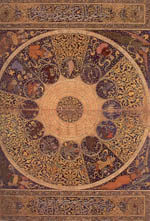 artist-princes of Samarqand and Herat. Briefly ruler of Samarqand and
later of Kabul, Babur ended up as ruler of north-west India from 1526 to
1530, where he founded the Mughal empire. Babur's memories reveal him to
have been extremely aware of the beauty of landscape. His visual
sensibility was shaped by his familiarity with Persian painting: When he
saw a striking arrangement of apples and leaves on a particular tree, he
commented that "if painters exerted every effort they wouldn't have
been able to depict such a thing." Clearly, he was a connoisseur
and critic of painting, but perhaps also a rather native one. Thus, in
commenting on the art of Bihzad, he confined himself to remarking that
" He painted extremely delicately, but he made the faces of
beardless people badly by drawing the double chin too big. He drew the
faces of bearded people quite well."
artist-princes of Samarqand and Herat. Briefly ruler of Samarqand and
later of Kabul, Babur ended up as ruler of north-west India from 1526 to
1530, where he founded the Mughal empire. Babur's memories reveal him to
have been extremely aware of the beauty of landscape. His visual
sensibility was shaped by his familiarity with Persian painting: When he
saw a striking arrangement of apples and leaves on a particular tree, he
commented that "if painters exerted every effort they wouldn't have
been able to depict such a thing." Clearly, he was a connoisseur
and critic of painting, but perhaps also a rather native one. Thus, in
commenting on the art of Bihzad, he confined himself to remarking that
" He painted extremely delicately, but he made the faces of
beardless people badly by drawing the double chin too big. He drew the
faces of bearded people quite well."
Islamic Art
Robert
Irwin
|